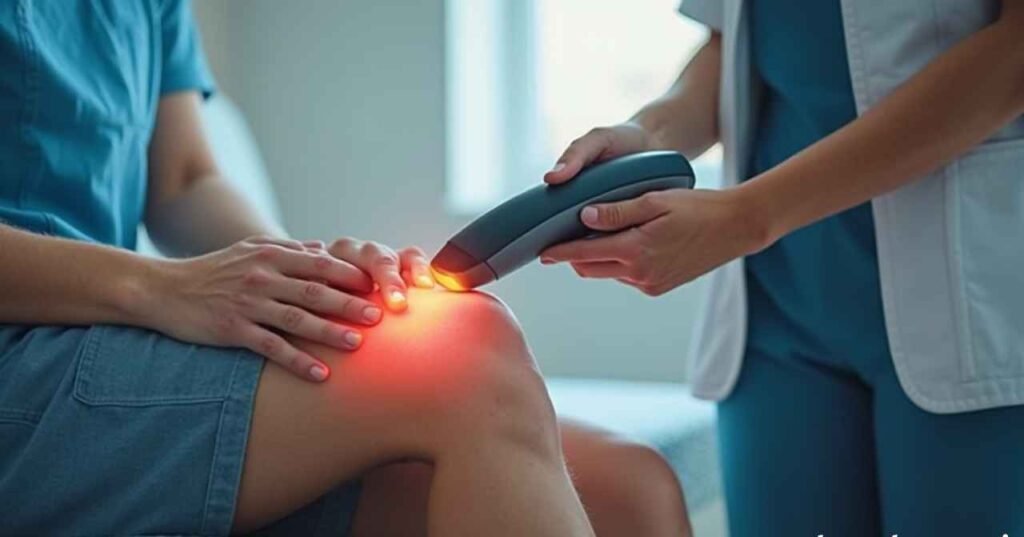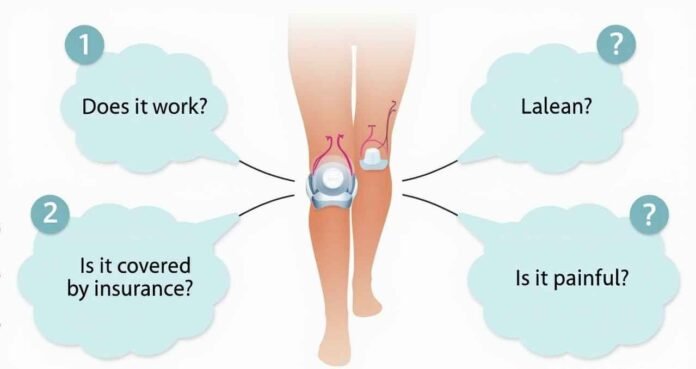Millions of people experience knee pain each year, and its causes range from osteoarthritis and sports injuries to chronic inflammation and stiffness following surgery. SoftWave Therapy has become one of the most promising non-invasive knee treatments available. However, questions arise when innovation occurs.
The most frequent and significant queries regarding SoftWave Therapy are addressed in this frequently asked questions guide, particularly those concerning knee pain relief, efficacy, cost, coverage, and safety.
Table of Contents
SoftWave Therapy For Knee FAQs
✅ 1) Is SoftWave Therapy Covered by Insurance?
Most insurance companies, including Medicare and Medicaid, do not currently cover SoftWave Therapy. Many insurers categorize the therapy as “alternative” or “investigational” because it is still regarded as a relatively new type of regenerative treatment.
To lessen the financial burden, some clinics, however, accept Flexible Spending Accounts (FSA) and Health Savings Accounts (HSA) or provide payment plans. It’s always a good idea to ask the clinic directly and check with your insurance company. Rarely, if a doctor prescribes it, workers’ compensation or VA benefits may consider partial reimbursement.
Pro Tip: Get a written invoice and diagnosis code from your provider to submit a manual claim if you want to try reimbursement.
✅ 2) Does SoftWave Therapy Work for Knees?
Yes, clinical studies and real-world patient outcomes show that SoftWave Therapy is effective for reducing pain and improving knee function, particularly in conditions like:
- Osteoarthritis
- Patellar tendonitis
- Meniscal injuries
- Bursitis
- Post-surgical recovery
- Chondromalacia patella
The treatment works by delivering high-energy acoustic waves into the soft tissues around the knee, triggering:
- Enhanced blood circulation
- Reduced inflammation
- Stimulation of stem cells
- Collagen regeneration
- Pain signal desensitization
In one clinical trial published in the Journal of Orthopaedic Surgery and Research, patients with knee osteoarthritis treated with shockwave therapy showed significant improvement in pain relief, range of motion, and function compared to control groups.
Most patients begin to feel relief after 1–2 sessions, with optimal results after 3–6 treatments.
✅ 3) Does Laser Therapy on Knees Work Compared to SoftWave Therapy?
Laser therapy and SoftWave Therapy are both non-invasive, but they differ significantly in how they work and what they treat.
| Feature | Laser Therapy | SoftWave Therapy |
|---|---|---|
| Technology | Low-level light (LLLT) | Acoustic pressure waves |
| Depth | Shallow tissue | Deeper penetration |
| Primary Benefit | Cellular stimulation | Regeneration, pain relief, circulation |
| Pain Relief Speed | Gradual | Often faster |
| Treatment Time | 10–20 mins | 10–15 mins |
Laser therapy may be more suitable for surface-level inflammation and minor injuries. In contrast, SoftWave Therapy reaches deeper tissues, making it better for chronic joint pain and ligament/cartilage repair.
SoftWave is generally more effective for moderate-to-severe knee issues, while laser therapy may complement it in a treatment plan.
✅ 4) Which Therapy is Best for Knee Pain?
While there is no one-size-fits-all treatment for degenerative and chronic knee pain, SoftWave Therapy is a great non-invasive option.
Comparison Table:
| Therapy | Invasiveness | Downtime | Cost | Effectiveness |
|---|---|---|---|---|
| SoftWave | Non-invasive | None | $$ | ⭐⭐⭐⭐☆ |
| PRP Injections | Minimally invasive | 1–2 days | $$$ | ⭐⭐⭐⭐☆ |
| Cortisone Shots | Minimally invasive | None | $$ | ⭐⭐⭐☆☆ |
| Physical Therapy | Non-invasive | None | $$ | ⭐⭐⭐☆☆ |
| Surgery | Invasive | Weeks/months | $$$$ | ⭐⭐⭐⭐⭐ |
SoftWave offers an excellent balance between safety, results, and patient comfort, making it a preferred option for many people before resorting to surgery.
✅ 5) Does Shockwave Therapy Help Knees?
Yes — SoftWave is a type of focused shockwave therapy, and it is well-studied for knee pain.
Shockwave therapy has been shown to:
- Reduce inflammation
- Desensitize pain nerves (nociceptors)
- Trigger biological healing
- Promote angiogenesis (new blood vessel formation)
When compared to control groups or conventional physical therapy, extracorporeal shockwave therapy significantly decreased pain in patients with osteoarthritis in the knee, according to a 2020 meta-analysis published in Clinical Rehabilitation.
Therefore, shockwave therapy, particularly SoftWave’s targeted technology, is something to think about if you’re struggling with persistent knee pain.
✅ 6) How Many Sessions of SoftWave Therapy Are Needed for Knee Pain?

Most patients need between 3 to 6 sessions, spaced 1–2 weeks apart.
- Mild cases (e.g., early osteoarthritis): 3–4 sessions
- Moderate to chronic pain: 4–6 sessions
- Post-surgical or athletic injuries: May require ongoing maintenance every few months
Many people feel immediate improvement after the first or second session, but long-term results improve as tissues heal over time.
✅ 7) Is SoftWave Therapy Painful or Uncomfortable?
Most patients describe SoftWave Therapy as a tapping or pulsing sensation, not painful.
- During treatment: You might feel mild discomfort, especially over inflamed or injured tissue.
- After treatment: Temporary redness or slight soreness for 24–48 hours is possible.
Because it’s non-invasive and doesn’t involve needles or cutting, SoftWave is far more comfortable than many traditional interventions.
✅ 8) Are There Any Risks or Side Effects with SoftWave Therapy?
SoftWave Therapy is FDA-cleared and considered very safe, especially compared to surgery or long-term medication use.
Mild side effects may include:
- Temporary soreness
- Redness
- Slight swelling
These effects usually resolve within 1–2 days.
Serious side effects are rare, but patients with:
- Blood clotting disorders
- Active infections
- Pacemakers (in treatment area)
…should consult their doctor before undergoing treatment.
✅ 9) Can You Do SoftWave Therapy at Home?
The OrthoGold 100 and other SoftWave Therapy devices are professional-grade medical equipment , to operate such devices safely and effectively we need individuals that are properly trained and certified to use .
But there are less powerful options for home use:
- PEMF (Pulsed Electromagnetic Field) devices
- Home-use ultrasound therapy
These may offer limited relief but are not a replacement for clinical-grade SoftWave Therapy.
✅ 10) How Much Does SoftWave Therapy Cost?
The cost of SoftWave Therapy varies depending on location, clinic, and treatment plan.
Typical pricing:
- $100–$200 per session
- Package deals (3–6 sessions) may offer discounts
- Some clinics offer first-time specials ($49–$69)
Tip: Ask the clinic if they accept HSA/FSA funds or provide financing options.
✅ Conclusion
SoftWave Therapy is becoming a popular choice for people with chronic or injury-related knee pain, especially those who want a non-invasive, drug-free, and surgery-free way to treat it. It’s changing how knee pain is treated, and there are thousands of success stories and scientific evidence to back it up.
Still curious about the procedure or where to get it?
👉 Read our full guide: SoftWave Therapy for Knees: A Complete Guide to Non-Invasive Pain Relief


